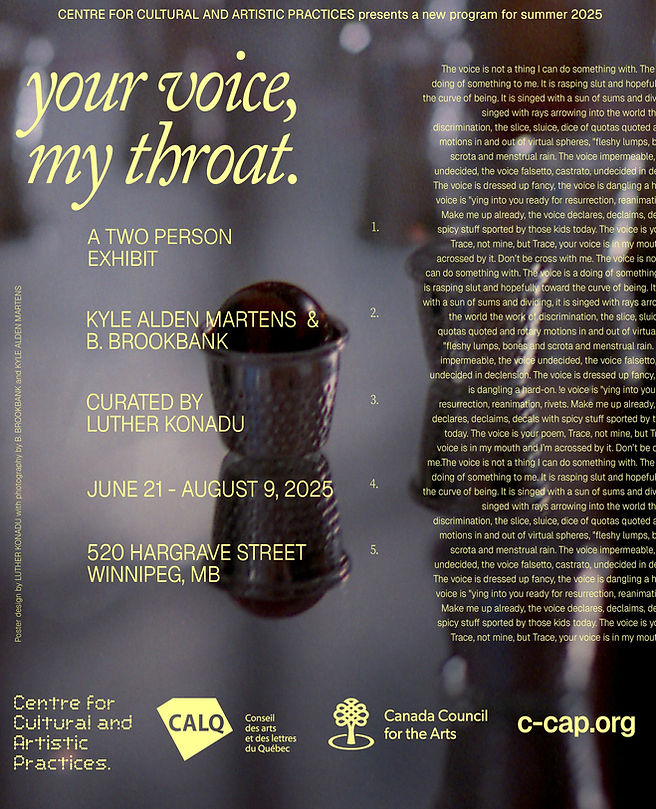Located on Treaty 1 territory, Winnipeg, Manitoba.

your voice, my throat
a two-person exhibit by
Kyle Alden Martens &
B. Brookbank
June 21, 2025 - August 09, 2025
What can it mean to orient one’s voice within another’s throat and reflexively, for the throat to find its capacity for a voice in the other? The ‘voice’ here is a form of agency, and the ‘throat’, the armature through which that very sense of agency becomes possible. The potential to find residence or orientation as Sara Ahmed explores in 'Queer Phenomenology: Orientations, Objects, Others', within the other is of interest here in proposing a kind of disorientation of binaries present within the works featured in this exhibition–‘your voice, my throat.’
The exhibit brings together, for the first time, Montreal-based artists B. Brookbank and Kyle Alden Martens, two artists whose work, although approached from diverging directions, shares distinct affective sensibilities and, just as significantly, are life partners. This latter point is one frame for the exhibit insofar as each artist’s work is indirectly and directly given its internal agency as a result of their over-decade-long partnership.
Brookbank’s work, starting with his photographs, summons an imaginary landscape of domesticity through an attentive precision of assembled objects and bodily forms poised under an equally exacting shadowy lighting design. Because his tableaux are caught in the cinematic grey scales of darkroom processes with their soft grain and tenderly-focused edges, they seem to exist in an oneiric subterranean. His photographic spaces, intuitively orchestrated, seem to exist on a precipice between realities. Like entering a dream in media res, the photographs are suggestive of Brookbank’s own psychological states as if surfacing spectres within regions of the artist’s subconscious otherwise submerged.
Disparate objects from his and his family's home are playfully re-presented out of their expected contexts and in the dramaturgical staging of the image to an unhomely yet alluring effect. The experience of these scenes is one atmospherically sensed, even if elusively, rather than tethered to any definitive language or narrative. Parallels to Freud’s unheimliche or uncanny—similarly to Ahmed’s (dis)orientation—are in many ways present through Brookbanks’ work in the exhibition. These unheimliche junctures are when the familiar lapses with the unfamiliar or the unfamiliar appears strangely familiar, especially in the space of a home. Brookbank’s constellation of household objects becomes obliquely strange in his scenes, including the installation of flattened spoons strewn on the gallery floors, devoid of their use. They seem to have crawled from the domestic spaces referenced in the images and taken on their own sentience. The video installation in the basement also carries the fluidity and fecundity of a dream state through a lyrical montage of still life stagings shot on the warm hues of 16mm film. The tactile ambient sounds that flit in and out of the video are sonic extensions and analogues to the amorphous air of the photographs.
For Ahmed, the home, like the larger social order (sexual, gender orientation, etc) with its ideological frameworks, is a preset, one spatial ground zero of existence, and one point of inevitable orientation for many. However, this pre-existing social backdrop is innately undergirded by compulsory heteronormative intimacies that assumes the reproduction and the continuation of family line; as such, what could it mean to orient a queer subject in this space? That is, a subjectivity that deviates from the precondition of the spatial relation through which they move. Ahmed views this experience as a foundational disorientation particularly when the queer subject extends themselves to be oriented in this predetermined dwelling. The failure of being unable to orient is one of uneasiness and friction. What I described as an air of unheimlich that shadows Brookbank’s work is in many ways rooted in Ahmed’s deviation of orientation, so that the circumscribing effect of this is one of surreal uncertainty.

.jpg)
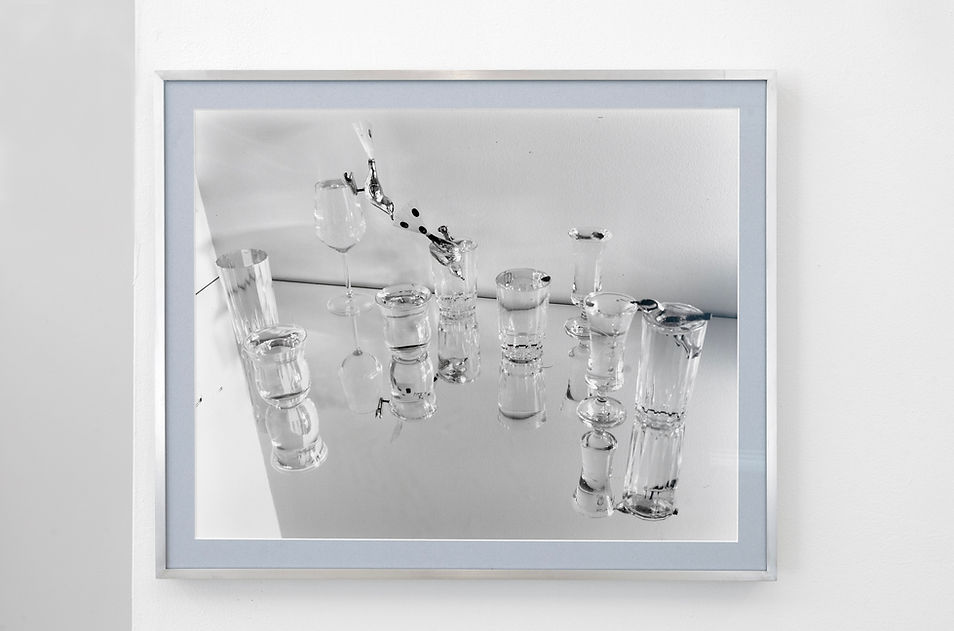
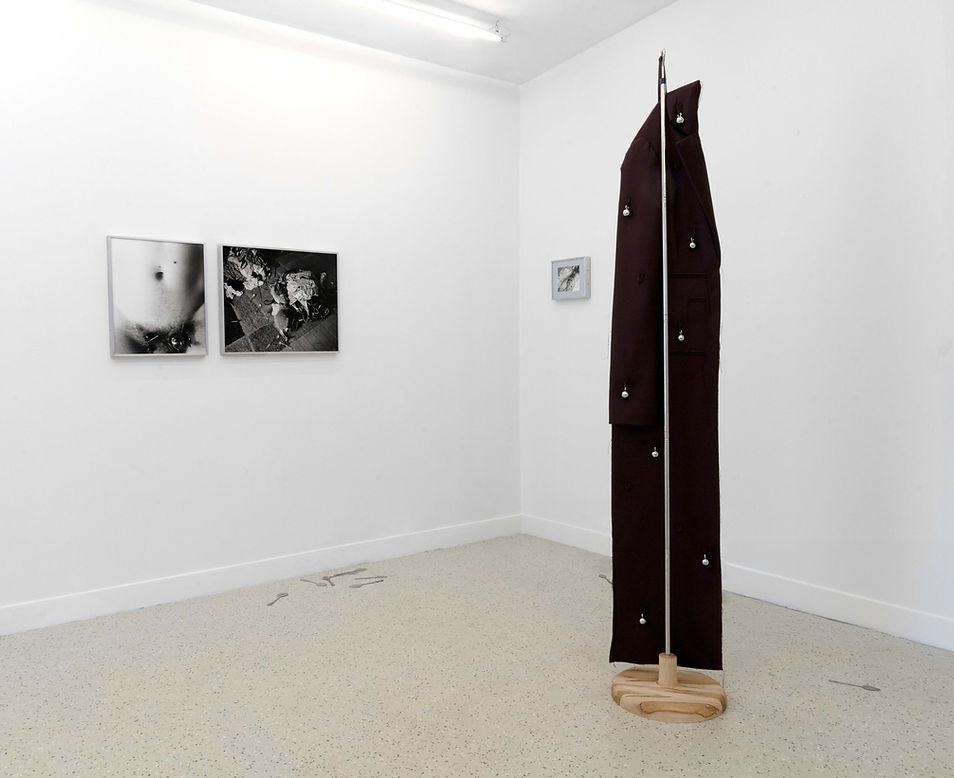
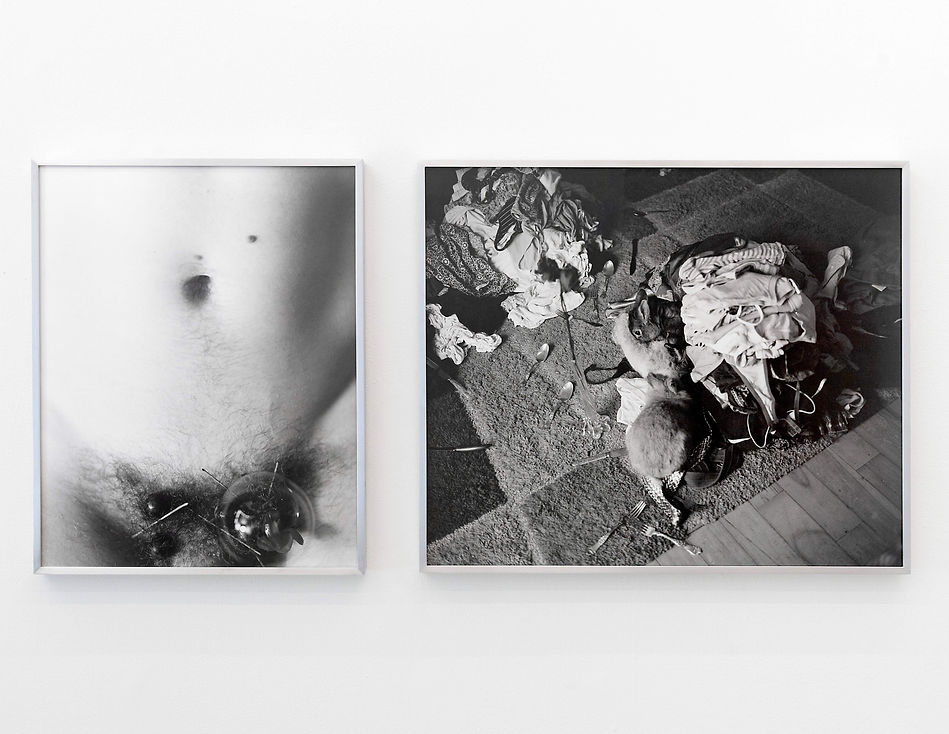
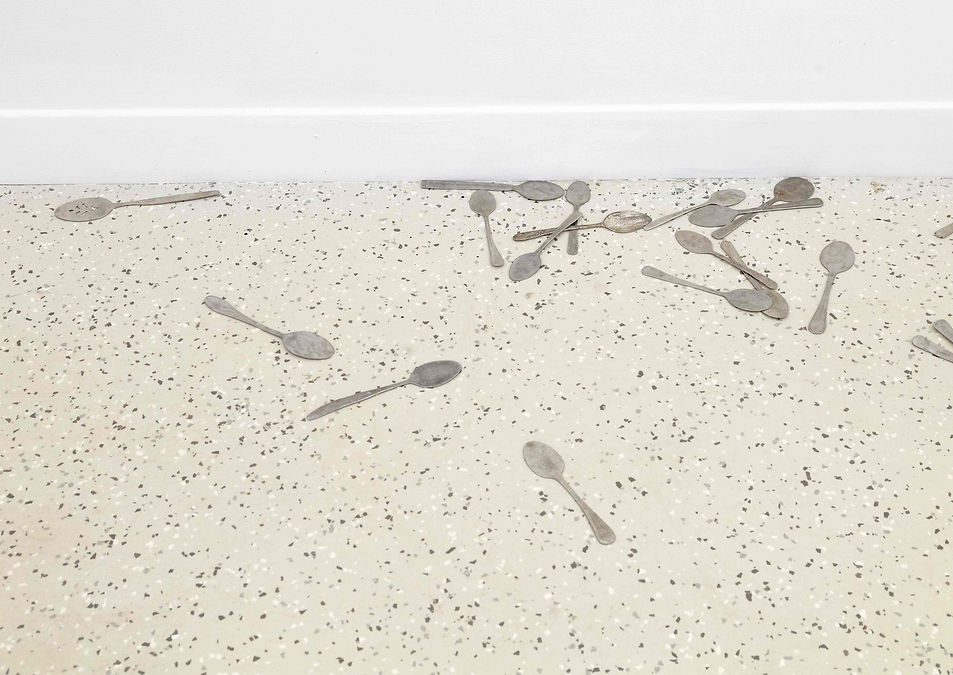

.jpg)

Martens’ sculptural configurations engage within closets more broadly. Its a site of orientation for the queer subject within the home, both as a choice and out of necessity on one end, as well as a site of clandestine cathexis beyond its physicality. It is where signifying logics with the world outside are attuned and perfected so that orientation toward queer desire is attained. For Martens’ work, the sartorial objects that take up that space of the closet do a lot of that signification of identity. However, the artist’s acute attention to this signification leads him to circumvent garments, challenging their ideological fittedness or givens especially for the queer subject. Garments are starting points of reference for the artist, deviating away from their meaning until they become fluid, and less scrutable to an uncanny effect.
Martens’ free-standing creations take on the statue form in their physical uprightness, invoking the body in the abstract and declaring their autonomy in space. Upon a cursory glance, their reference seems recognizable, but that recognition comes apart on closer view. Martens takes on the standard processes and materials of a tailor; however, he complicates their very process often in a counterintuitive direction, reverse-engineering, making the very act of tailoring seem an alien and strange endeavour. The exhibit hosts a trio of sculptures that first seem like vertically folded and compressed trench coats, hung like in a travel garment bag for an implied figure on a business trip. The dress tie installation in the basement, with its paternalistic inferences, is a complement to the ensemble. A closer look reveals the coats to be a mere profile section, not folded but designed to be unfit for the body–the limbs, collar and pockets are sealed off so that it's unwearable. What’s more, it's adorned with tiny weights of trinkets, including elongated wrist watches, which are also unwearable. These adornments further impede the supposed function it appeared to have. The ties are equally as skewed for their absurd length while remaining recognizable. They signify as familiar but upend that familiarity, keeping the viewer in the position of disorientation, straying us from the habituated.
I like to think of Martens’ disembodied figural sculptures as starring presences or objects in Brookbank’s nocturnal theatre of objects and effects. Inversely, I think of Brookbank’s photographic environments as a backdrop against which Martens’ obstructed constructions orient and play. Their works combine to mean something more than their individual parts. They undermine a staid legibility and elicit our curiosity, in so doing giving space for minds to wander.
- LUTHER KONADU, curator
Kyle Alden Martens (b. Saskatchewan) is an artist who works through sculpture, installation, performance, and video. In their practice they construct sculptural work that engages with ideas of how clothing is tailored to fit the body while repositioning queerness to disrupt symbolic and physical structures. Martens holds an MFA in Sculpture from Concordia University and a BFA in Intermedia from NSCAD University. Their practice has been supported by the Canada Council for the Arts, CLAQ, the Dale and Nick Tedeschi Arts Fellowship, SSHRC, and FRQSC. Their work has been shown in exhibitions and fairs across Canada and North America, including Centre Clark, Bradley Ertaskiran, Pangée, Circa Art Actuel, the Leonard & Bina Ellen Art Gallery (Montreal), the Khyber Centre for the Arts (Halifax), Stride Gallery (Calgary), Eastern Edge Gallery (St John’s), Barely Fair (Chicago), Nada Foreland (Catskill), Feria Material (Mexico City), and Patel Brown (Montreal & Toronto). Martens has been a resident at Acre Residency, Daïmôn Centre, and the Brucebo Fine Art Residency in Sweden among others. Martens is a recent laureate of the Claudine and Stephen Bronfman Fellowship in Contemporary Art hosted at Concordia University. Recent projects include a group exhibition titled "The Past Tense is Always Longer" curated by Anaïs Castro. Upcoming projects include solo exhibitions at Diagonale, FOFA, and Écart. Martens is represented by Patel Brown and based in Montreal.
B. Brookbank is an artist from Nova Scotia, Canada, currently working in Montréal. Their practice considers the language and poetics of photography, through an interdisciplinary approach that includes moving image, installation, sculpture and writing. They have had solo exhibitions at Leonard & Bina Ellen Gallery and Centre Clark (Montréal), Écart (Rouyn-Noranda), and the Anna (Halifax). Select group exhibitions took place at Patel Brown (Montréal and Toronto), Centre Clark (Montréal), and Eyelevel Gallery (Halifax). Their practice has been supported through various grants and awards such as Concordia Faculty of Fine Arts Fellowship, Roloff Beny Photography Foundation, and the Canada Council for the Arts. They were an artist in residence at Est-Nord-Est (Saint-Jean-Port-Joli) in 2024 and at the Banff Centre for the Arts (Banff) in 2025. Brookbank holds an MFA in Photography from Concordia University and a BFA in Photography from the Nova Scotia College of Art and Design.
